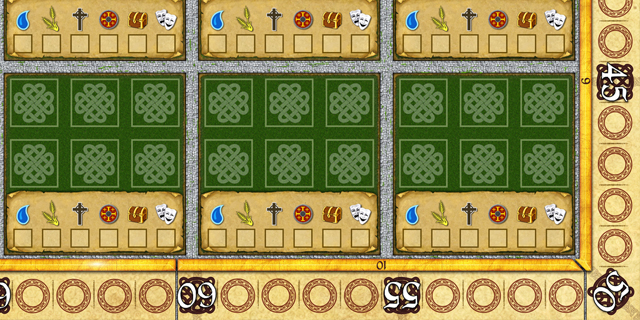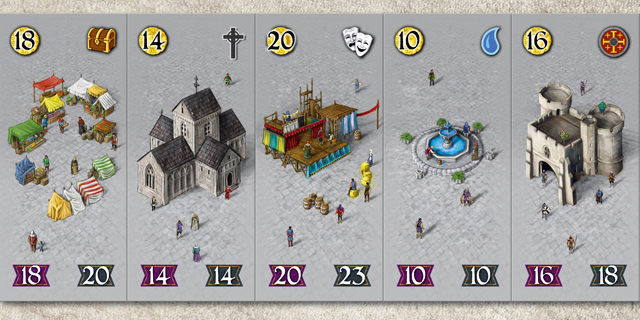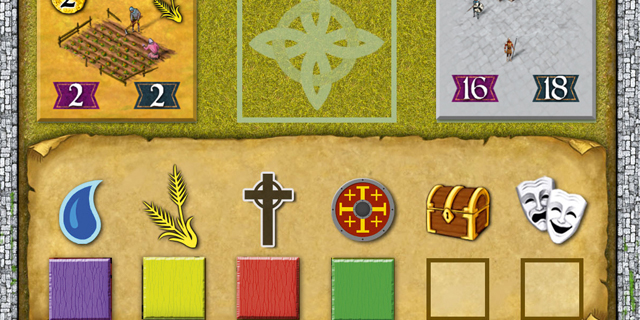
Most games include some inherent element of randomness, typically either the draw of a card or tile, the roll of a die or both. There are some exceptions, notably abstracts or cat-and-mouse deduction games, but even pillars of strategic gaming like Agricola have variables that change from game to game to mix things up. In Canterbury, designer Andrew Parks has offered up an experience with no randomness (other than determining start player) that still manages to play out differently each time.
The goal of Canterbury is to gain the most prosperity (points) as you and the other players build and develop the titular city. Starting with only an old Roman well, the city will eventually spread out to encompass up to 25 districts. Each turn, a player chooses to either collect taxes (amount determined by the city’s overall prosperity level), execute a Full Build action (one or two smaller structures or one large structure), or to combine both to collect half the normal amount of taxes and then build a single structure. Players who elect to levy funds must choose Full Build on the following turn, but other than that there are no restrictions on which action you can execute.
Each structure provides one of six services to its district: water, food, religion, defense, commerce or culture. In order to build a given structure in a district, all of the more basic services must be provided to that district. For example, a Chapel cannot be constructed in a district until a it has access to both water and food. Small structures only provide services locally, but larger ones have greater influence over neighboring districts.

Whenever a structure is built, it provides overall prosperity to the city as well as providing points to the player who built it. When the city’s prosperity crosses certain thresholds, district favor is scored. Every district receiving a newly-built structure’s service also has one of the player’s cubes placed on its service indicator. Whoever provides the most services to a given district scores points equal to the number of that district’s spaces occupied by structures (to a maximum of six); second place scores half that, rounded down. Ties split the points but also eliminate any second place bonus (a tie for second means no second place). District favor will be scored four times during the game, and can be a vital source of points, especially if you can establish dominance in a full district early.
Bonus prosperity can be scored as you build in several ways. Placing a medium or large structure often means that smaller structures must first be demolished. There are restrictions as to when structures can be demolished, but whenever you effectively upgrade a structure with one providing the same service you gain three bonus points. Breaking ground in a previously undeveloped district will also earn you points at the end of your turn for every service being provided to it. Finally, at the end of the game the players who provided the most of each service will gain points according to the King’s Bonus track.

What makes the lack of randomness work in Canterbury is the fact that every action taken by a player changes the options available to those who go next. Districts must spread from adjacent districts, so (almost) every broken ground opens up new areas for construction. Providing services opens up new possibilities for which structures can be built — and upgraded — there. Building structures increases the city’s prosperity, which in turn increases the amount of taxes collected, but collecting taxes telegraphs that you are building at least one structure next turn and the amount of gold you have will indicate which ones are available to you. But… how many are you actually going to build? Do you want to maximize your output or just build a cheap throwaway Well to save your gold for a bigger play in a future turn? Structures you build in districts where you don’t have the most influence are also going to give points to whoever does unless you can somehow wrest majority from them by doing so.
The game ends after the city reaches 301 prosperity (which is its limit), after which the current round is completed and then each player gets one more turn (assuming the last player isn’t the one to cross that threshold) before the final district favor scoring. Speaking of district favor, which structure(s) you build will affect how soon the city’s prosperity crosses the thresholds. Do you want to push it over the limit to trigger scoring, or maybe hang back to shore up your influence for when scoring does happen?

It’s fascinating to me to watch this game play out. It almost feels like a multiplayer abstract, which is something I rarely get to experience. Initially I feared that a game with no randomness could be “solved,” that an optimal play existed at every point, but having played a few times now I no longer worry about that. Yes, the game is going to be prone to analysis paralysis, especially in the later stages, but at that point there aren’t really that many options to go through. The services available to each district dictate what can and can’t be built, so if you want to put down, say, a medium-sized commerce structure there are only so many places it can actually go. More important is keeping an eye on both the district favor race and minding the King’s Bonus tracks. Among similarly-skilled players, scoring will often be quite tight, and victory will be determined by whoever can scrape together enough small bonuses to pull ahead.
Canterbury normally supports three or four players, although advanced rules for two are included. A session will take anywhere from 60 to 90 minutes, depending on number of players and possible AP drags. My only problem with the components are the wooden cubes used for everything. It would have been nice to get discs for the score and King’s Bonus tracks, as they stack easier. We do get discs, and a unique marker for the city’s prosperity, but I don’t know enough about the logistics of board game manufacturing to speculate as to why more wouldn’t have been possible. The cubes are fine, just awkward. And there are a lot of them, about 50 per player. Combined with the copious amount of cardboard for structure tiles and other boards, this is one large, heavy box. That size and weight will undoubtedly come with an price to match (I would speculate $60, but there is no information about that yet) when it hits game store shelves later this month.



















